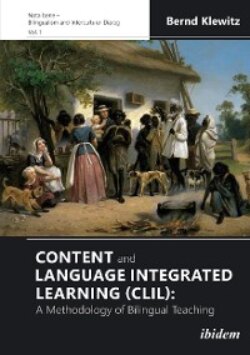Читать книгу Content and Language Integrated Learning (CLIL): A Methodology of Bilingual Teaching - Bernd Klewitz - Страница 7
1.2 The Guide for Bilingual Parents
ОглавлениеThe conviction that bilingualism is right for his family and even intensifies their relations in a special way is shared by longstanding scientific research on bilingualism in early childhood presented in a most recent Guide for Bilingual Parents by Professor Jürgen M. Meisel. The former Chair of the Research Center on Bilingualism at the University of Hamburg has been counselling parents for more than 35 years in both Germany and Canada (University of Calgary), and expertly confronts the advantages and—in his own words—“mostly mythical drawbacks of raising children with a command of two or more languages” (Meisel 2019: cover). A closer look at risks and benefits will become useful for an integrative bilingual methodology which aims at successive bilingualism in the long run.
Discussing so-called risks of early childhood bilingualism, Meisel’s parental guide draws upon the following “rumors” first, namely
whether two languages can be kept apart,
how to avoid a “macaronic language mix” (Meisel: 8; 58),
that balanced bilingualism is not possible and puts excessive strain on mental capacity,
that fusion of two languages affects cognitive development and would lead to semi-linguals with children torn between two languages and cultures, thus unable to develop their own personalities (cf. ibid.: 7 ff).
There seems to be sufficient evidence, however, that children can distinguish between different languages at an early stage already and Ava’s reaction to her grandfather is a case in point (see case vignette above). Various, even opposing theories of Second Language Acquisition (SLA) support the view that the mental grammars of bilinguals develop independently, whether one follows a generative SLA with Chomsky’s Universal Grammar (UG), the so-called Human Language Making Capacity (LMC; supported by Meisel: 35), its radical version of the Fundamental Difference Hypothesis (FDH, Bley-Vroman 2010) or more recent approaches in cognitive theory, constructivism and the findings of neuro-science. The alleged “macaronic language mix” turns out as code-switching and the sign of a conscious choice as “the ability to select languages according to interlocutor, situational context, topic of conversation etc.” (Meisel: 72). All these paradigms do not only refer to childhood simultaneous bilingualism but also pertain high relevance for successive bilingualism in CLIL programs and are therefore discussed in the following juxtaposition between a nativist and a cognitive position (see chapter 2). Code-switching itself becomes part of CLIL-tools and as “translanguaging” works together with other linguistic skills such as mediation, visual representations and digital implements in the context of interactive methods, instructional strategies and scenario techniques (see 8.2-8.5).
On the bilingual credit side are the following aspects:
accelerated language acquisition is one of the undisputed benefits of bilingual development,
native-speaker competence seems possible, provided a sufficient input is available,
reading skills and favorable intelligence tests are counted as further added value, based on neurological advantages,
bilingual children become part of another social world,
they are able to express the same ideas in two languages,
they are immersed in cultures negotiating different meanings and values.
Meisel’s guidebook for “bilingual parents” is listing these and further benefits to encourage these processes and advising adults to persevere in their attempts to create rich, multi-lingual situations (cf. Meisel: 7 ff, 221 ff).
